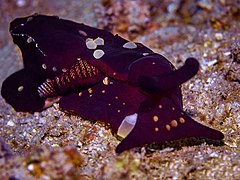
Back عيثنور Arabic Euthyneura Spanish راستپیها Persian Euthyneura (mollusque) French Eutineuros Galician Euthyneura ID Euthyneura Italian 직신경류 Korean Euthyneura Dutch Euthyneura Portuguese
| Euthyneura | |
|---|---|

| |
| Cepaea nemoralis | |
| Scientific classification | |
| Domain: | Eukaryota |
| Kingdom: | Animalia |
| Phylum: | Mollusca |
| Class: | Gastropoda |
| Subclass: | Heterobranchia |
| Infraclass: | Euthyneura Johann Wilhelm Spengel, 1881[1] |
| Diversity[2] | |
| Over 30000 species | |
Euthyneura is a taxonomic infraclass of snails and slugs, which includes species exclusively from marine, aquatic and terrestrial gastropod mollusks in the clade Heterobranchia.
Euthyneura are characterised by several autapomorphies, but are named for euthyneury. They are considered to be the most successful and diverse group of Gastropoda. Within this taxon, the Gastropoda have reached their peak in species richness and ecological diversity. This obvious evolutionary success can probably be attributed to several factors. Marine Opisthobranchia, e.g., have evolved several clades specialised on less used food resources such as sponges or cnidarians. A key innovation in the evolution of Pulmonata was the colonization of freshwater and terrestrial habitats.[3]

Various phylogenetic studies focused on Euthyneura: Dayrat et al. (2001),[4] Dayrat & Tillier (2002)[5] and Grande et al. (2004).[6] Morphological analyses by Dayrat and Tillier (2002)[5] demonstrated the need to explore new datasets in order to critically analyse the phylogeny of this controversial group of gastropods. Klussmann-Kolb et al. (2008) traced an evolutionary scenario regarding colonisation of different habitats based on phylogenetic hypothesis and they showed that traditional classification of Euthyneura needs to be reconsidered.[3]
- ^ Johann Wilhelm Spengel (1881). "Die Geruchsorgane und des Nervensystem der Mollusken". Zeitschrift für wissenschaftliche Zoologie 35(3): 333-383.
- ^ Cite error: The named reference
Kano 2016was invoked but never defined (see the help page). - ^ a b Klussmann-Kolb A., Dinapoli A., Kuhn K., Streit B. & Albrecht C. (2008). "From sea to land and beyond – New insights into the evolution of euthyneuran Gastropoda (Mollusca)". BMC Evolutionary Biology 2008, 8: 57. doi:10.1186/1471-2148-8-57.
- ^ Dayrat B., Tillier A., Lecointre G. & Tillier S. (2001). "New clades of euthyneuran Gastropods (Mollusca) from 28S rRNA sequences". Molecular Phylogenetics and Evolution 19(2): 225-235. doi:10.1006/mpev.2001.0926.
- ^ a b Dayrat B. & Tillier S. (2002). "Evolutionary relationships of euthyneuran gastropods (Mollusca): a cladistic re-evaluation of morphological characters". Zoological Journal of the Linnean Society 135(4): 403-470. doi:10.1046/j.1096-3642.2002.00018.x
- ^ Grande C., Templado J., Cervera J. L. & Zardoya R. (2004). "Molecular Phylogeny of Euthyneura (Mollusca: Gastropoda)". Molecular Biology and Evolution 21(2): 303-313. doi:10.1093/molbev/msh016.